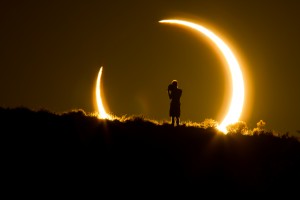
Middle Tennessee is in the eclipse zone. On August 21, my city will be inundated with people traveling from thousands of miles to witness a total eclipse, a rare event in which the moon obstructs the sun for several minutes.
Here’s how those who have experienced this phenomenon describe the moment:
The wind picks up a bit, and the temperature drops noticeably. Birds roost, evening insects come out, and the world prepares for sunset in the middle of the day. . . .
The sky surrounding the Sun will grow very dark very quickly. In real time, you will be able to see the deep blue turn to twilight blue, and then to bluish-black. Stars and planets will pop out of nowhere. Roosters will crow and insects will chirp as though night is falling. . . .
While the last bit of the sliver is shrinking, the Sun’s corona will start to come out. The last little bit of the Sun’s light will glare through valleys on the Moon, and will create a “bead” effect at the edge of the Moon’s disk. Around the edge of the Moon, the Sun’s corona will begin to glow, giving us the famous “diamond ring” effect. It lasts for only about 2-3 seconds, but it is stunning beyond words.
On videos of a total eclipse from other parts of the world, people cheer and clap when the moment occurs. It’s as if everyone is overcome by artistry of the Creator and feels the need to join in nature’s applause.
I’m going to watch the eclipse. I won’t try to capture it on film or on my phone because I want to enjoy the rarity of the moment for what it is. This will not happen again in my hometown in my lifetime, and I don’t want to see it through my camera. (I’m just praying it doesn’t rain!)
I will stop and pause for the eclipse. But this makes me wonder: Why don’t I do this more often? Am I as attuned as I should be to the glories that surround me all the time?
C. S. Lewis: Attuned to Wonder
This year, I’ve been reading through the letters of C. S. Lewis. In the late 1930s and early 1940s, Lewis’s letters to his brother, serving in WWII, offered vivid descriptions of the land and sky. The level of detail in Lewis’s letters challenges me. He noticed things in his environment that I rarely see in mine, not because they’re not there, but because my eyes aren’t open.
On December 3, 1939, for example, Lewis speaks of the color of the morning—the color!
“Tuesday I was in Addison’s walk for a few more minutes than usual before going to chapel, and enjoyed very much the effects of a clear still morning (sky of pigeon-grey, pearl-grey, and, eastward, pale butter colour verging on cream) on a state of partial flood.”
This emphasis on the color of the atmosphere shows up again and again. Lewis speaks easily of the contrast between a sky of “spring gray”—long level clouds of white, silver, pearl, and dove-colour” and “winter gray”—ragged and pleated clouds of iron colour,” as well as “hot summer gray or celestial damp blotting paper.”
In other letters, Lewis describes the difference between walking a path after a few days of rain and walking a path after several weeks of drought. He felt the ground underneath him.
On the last day of 1939, Lewis describes a magical evening, noting the stars and planets:
“I thought I had never seen this place more beautiful. Just behind me a moon, the colour of a harvest moon, was rising: the sky was blazing ‘with few, but with how splendid stars’, Jupiter among them: the grass was frosty: into the dimness ahead stretched the white concrete slabs of the path leading the eye on to the dark gable-end of the Kilns proper. An absolute enchantment . . . ”
This was a man who was conscious of the wonders around him. He noted the “pleasant glimpse of rabbits lolloping across the pond” before breakfast. He described the arrival of “bird music” and the announcement of spring through the view from his dining room window: “whenever you look away and look back at it, it seems to have got greener in the interval.” He noticed the “first primrose” of the year.
‘I Shall Open My Eyes and Ears’
This year’s eclipse and Lewis’s letters remind me of professor Clyde Kilby’s resolutions:
At least once every day I shall look steadily up at the sky and remember that I, a consciousness with a conscience, am on a planet traveling in space with wonderfully mysterious things above and about me.
I shall open my eyes and ears. Once every day I shall simply stare at a tree, a flower, a cloud, or a person. I shall not then be concerned at all to ask what they are but simply be glad that they are. I shall joyfully allow them the mystery of what Lewis calls their ‘divine, magical, terrifying and ecstatic’ existence.
When God created the world, all the angels shouted for joy (Job 38:4-7). The God who sings over his creation is the God who rejoices in his works (Psalm 104:31). If God delights in the work of his hands, shouldn’t we? And shouldn’t the wonders of creation lead us to praise and thank him?
So, let’s not wait until the next eclipse to stop and pause and wonder. Look up to the heavens, and then look further up, until you find joy in the God who enjoys his handiwork.


















